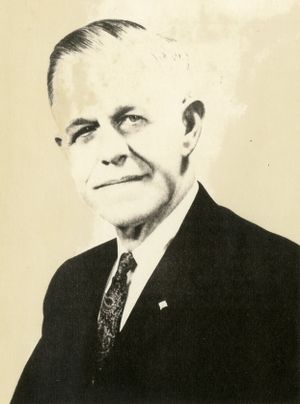Roger A. Sykes
Biography
Roger Allen Sykes is one of those unique individuals who has spent a lifetime doing the thing he loved most. Fortunately for the world of communications, what Roger Sykes enjoyed, it needed. He has a unique combination of mathematical ability and good, solid engineering judgment. These attributes, coupled with an inquisitive mind and knowledge of a field from its inception, have been responsible for his success.
Roger Sykes received his B.S. and M.S. Degrees in EE from the Massachusetts Institute of Technology in 1929 and 1930, respectively. Part-time employment with the Bell System as a student at M.I.T . led to full-time employment with Bell Telephone Laboratories upon graduation.
The group of young scientists and engineers which Roger Sykes joined included many of the illustrious names in the field of communications. During the 1930's this group was involved in planning telephone networks which would form the heart of the vast telecommunications network today in existence in this country. He and his associates were concerned with the problems of frequency division multiplex and the development of filter networks using the piezoelectric properties of quartz crystals. The results of this important development at Bell Laboratories, in which Roger played a leading role, led to the understanding of the basic physical properties of piezoelectric devices and their wide use in transmission networks.
At the beginning of World War II, the Bell Laboratories, under the leadership of Mervin J. Kelly, was committed to supplying frequency control devices for military communications. Roger Sykes took a fledgling crystal industry which has produced less than 100,000 devices in 1940 and, together with other scientists, formed it into an industry producing 5 million devices a year by 1943. This herculean effort contributed in an important way to the United States' successful involvement in World War II and vaulted Roger into a position of a world expert in the field of frequency control devices. During this time he worked closely with Dr. Kelly.
In 1946, Roger Sykes was given the important job of developing frequency control devices for the rapidly expanding telephone system. Between 1950 and 1970, his department was involved in important developments in precision timing, satellite communications, ultrasonic delay lines, and the development of monolithic crystal filters. He also had responsibility for ferrite devices, thermoelectric temperature control devices and ferroelectric crystal devices.
His work in these important fields has led to his being awarded nearly twenty patents. He has also published more than a dozen papers and contributed to three separate books. Mr. Sykes has also been very active in international standards work through the International Electrotechnical Commission and has represented the United States' position for many years at their meetings.
For his outstanding contributions to the field of frequency control, Roger Sykes has numerous awards. In 1967 he was chosen as a "Distinguished Engineer" by the Pennsylvania Section of Professional Engineers . In 1970 there was a special session at the 24th Annual Frequency Control Symposium honoring Mr. Sykes for "Lifelong Contributions to the Field of Frequency Control and Selection". He was a Fellow of the IEEE.
Roger resided with his wife, Mary, in their home in Bethlehem, Pennsylvania. During the summer Roger and Mary resided at Lake Sunapee, New Hampshire, where they enjoy a beautiful Swiss-style chalet, designed and partially contructed by Roger. He continues his active interest in frequency control through participation in technical committees in the IEEE and through standards work with the IEC.
